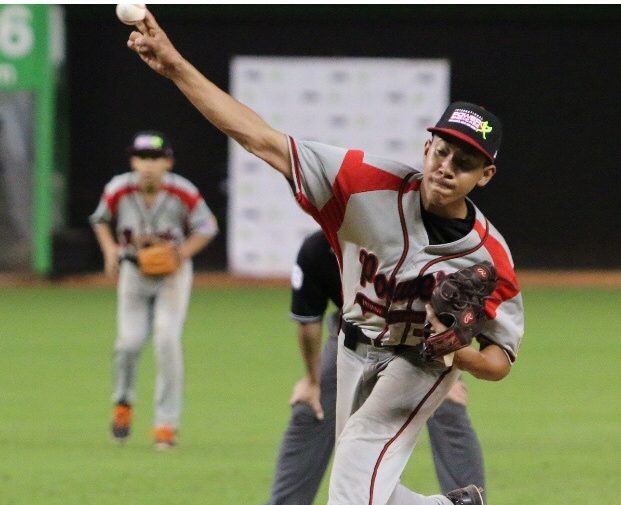
new.berecruited.com
Simeon Woods-Richardson
Position: SP B/T: R/R Age: September 27, 2000 (18)
Acquired: 2018 2nd Round Draft Pick from Kempner High School (Sugar Land, Texas)
2018 Stats (GCL & Kingsport): 1-0, 1.56 ERA, 1.096 WHIP, 2.1 BB/9, 13.5 K/9
Simeon Woods-Richardson is a name that Mets fans should get used to hearing.
The Mets surprised some people when they took Woods-Richardson with their second-round and the 48th overall selection last year. Considered a legitimate two-way threat, with an electric right arm and plus-raw power as a third basemen he was a consensus Top-200 draft prospect. Though his ranking varied widely, Baseball America had him pinned at 76, but MLB Pipeline ranked him 160th.
The variation in rankings for the then-17-year-old had a lot to do with some mixed scouting reports from the spring prior to his draft. Scouts were impressed with his size, makeup, and stuff, but seemed unenthused with his inability to sustain velocity late into games. Some reported that he topped out at 96 miles per hour but had been clocked into the upper 80s later in games. This is a relatively common bugaboo for young prep arms, but scouts were still concerned. Inability to maintain velocity can cue scouts into potential structural issues in a pitcher’s arm, either at the moment or even further down the road.
Woods-Richardson said that velocity concerns were blown out of proportion. “That was only one game and it was a two-inning start. Every game, I averaged 92-94 mph and topped out at 97.”
With his stock down and Woods-Richardson already having a college commitment at the University of Texas, anticipation was that he would not be drafted until the third or fourth round. Instead, the Mets took him in the second, at 48th overall. He signed an overslot deal worth $1.85 million.
Early returns on the 6’3” right-hander are extremely promising. The Mets started him with their Gulf Coast League team. He pitched in 11.1 innings across five games and did not allow a single earned run. He punched out 15 and only walked four. That was a good enough look for the Mets’ brass, who then sent him up to Kingsport. In two starts, he struck out 11 over 6.0 innings without walking a batter. His ERA between his two brief stints came out to 1.56 in 17.1 innings.
Woods-Richardson (or “SWR” as prospect writers have colloquially dubbed him) is an athlete in modest terms. More generously, he is a freak of nature. He had a Syndergaard-esque growth spurt between his freshman and sophomore years of high school, in which he shot up eight inches in height and put on about 40 pounds in weight, all while adding ten MPH on his fastball. His coaches allegedly did not recognize him after the transformation.
The Mets got a bulldog when they selected SWR. Literature on the right-hander constantly refer to him as an intense competitor. His size and strength for his age lends to a level of intimidation and momentum down the mound. Woods-Richardson works out of a modified windup when the bases are empty, starting his hands at face-level before bringing them to the belt as he steps back to begin the motion. His stride is long, as can be expected for a tall, flexible pitcher. His arm extends down toward his hip before whipping the ball through a high three-quarters arm slot. He does match the dreaded inverted W as he pushes through the rubber, which is somewhat concerning, but it is also a common problem. He finishes his motion by falling off to the first base side of the mound. Despite his unbalanced finish, the righty is still a consistent strike-thrower.
Woods-Richardson already works an impressive four-pitch mix. His fastball and curveball are his standout offerings. The fastball, which reportedly touched 99 MPH in a Mets uniform, might be his most polished offering. Consensus seems to be that it is already a solid 55 on the 20-80 scouting scale, with room to get even better. He sits 92-95 but consistently reaches back into the upper-90s.
The curveball is already a legitimate secondary offering for the right-hander. It generally breaks sharply off the table in a 12-6 fashion, but occasionally loops into a more slurve-like 11-5. The pitch has flashed as high as 55, but it could get even better with more consistent command.
Besides the fastball and curve, Woods-Richardson utilizes a cutter and a changeup. The cutter comes out of the same grip he uses for the curve, just without any added spin on release. It lacks the velocity of his fastball but also doesn’t break enough to be classified a true slider. Reports on his changeup are generally positive as well. It has good fading movement and a solid velocity differential with his fastball, so with help it could develop into his third plus-pitch.
Woods-Richardson is the kind of athlete that benefits from a professional development staff. At the moment, he is raw, but his ceiling is high nonetheless. After his impressive pro debut, there is a lot of helium beneath him. Some even seem to think that, if all goes right, he can be a fringe Top 100 league-wide prospect in a year’s time. That said, there is some volatility in his profile. Power pitchers with multiple plus-pitches always have a chance to be top flight arms, and he has already had flashes of that type of ceiling. But because of the youth and violent mechanics, he can just as easily end up a bullpen arm.
The fact of the matter with Woods-Richardson is that, quite frankly, we do not know what we will have until he progresses up the system. He’s as exciting and talented as he is young, and the ceiling is as high as any arm in the Mets system. Because of that, he should be fun to follow throughout his tenure in the minors, and it is partially why he is ranked so high despite being so young. One interesting thing to note on him is that he no longer has to split his focus between third base and the mound. With a pedigree in the Mets’ organization of developing power pitchers and a ton of talent in his right arm, the sky is the limit now that he can focus on pitching.
Editor’s Note: Jarred Kelenic, Justin Dunn, Luis Santana, Ross Adolph, Bobby Wahl, Adam Hill, Gerson Bautista, and Felix Valerio were all in our original Top 50 before they were traded.
Previous Rankings
50-46 Led by Michael Paez
45-41 Led by Ranfy Adon
40-36 Led by Anthony Dirocie
35-31 Led by Ryley Gilliam
30-26 Led by Chris Viall
25 Carlos Cortes
24 Ali Sanchez
23 Eric Hanhold
22 Luis Carpio
21 Freddy Valdez
20 Walker Lockett
19 Junior Santos
18 Gavin Cecchini
17 Jordan Humphreys
16 Christian James
15 Tony Dibrell
14 Francisco Alvarez
13 Will Toffey
12 Adrian Hernandez
11 Desmond Lindsay
10 Franklyn Kilome
9 Shervyen Newton
8 Thomas Szapucki

